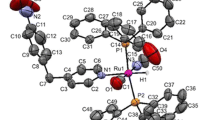Abstract
The kinetics of charge-transfer interaction betweenp-toluidine and iodine in methylene chloride was investigated in depth. Thethermal process of formation of the“inner” complex was found to proceed to an equilibrium. Thephotochemical process follows a different reaction coordinate, going through the formation of an exciplex between the excited“outer” complex and the amine ground state. In both cases the same ionic complex (Am 2I+I −3 , whereAm stands forp-toluidine) was detected as the final product.
Zusammenfassung
Die Kinetik der Charge-Transfer-Wechselwirkung zwischenp-Toluidin und Jod in Methylenchlorid wurde ausführlich untersucht. Derthermische Prozeß, der zur Bildung des„inner“-Komplexes führt, geht bis zu einem Gleichgewicht. Derphotochemische Prozeß folgt einer unterschiedlichen Reaktionskoordinate und verläuft über die Bildung eines Exziplexes zwischen dem angeregten„outer“-Komplex und dem Amin im Grundzustand. In beiden Fällen wurde derselbe ionische Komplex (Am 2I+I −3 , wobeiAm fürp-Toluidin steht) als Endprodukt festgestellt.
Similar content being viewed by others
References
Beggiato G., Casalbore G., Marconi G., Mastragostino M., Monatsh. Chem.114, 675 (1983).
Parker C. A., Photoluminescence of Solutions, pp. 208–214. Amsterdam-London-New York: Elsevier. 1968.
Benesi H. A., Hildebrand J. H., J. Amer. Chem. Soc.70, 2832 (1948).
Benesi H. A., Hildebrand J. H., J. Amer. Chem. Soc.71, 2703 (1949).
Rose N. J., Drago R. S., J. Amer. Chem. Soc.81, 6138 (1959).
Rose N. J., Drago R. S., J. Amer. Chem. Soc.81, 6141 (1959).
Mastragostino M.,Biserni M., unpublished results.
Handbook of Chemistry and Physics (Weast R. C., ed.), 63rd ed. Cleveland: CRC Press. 1982–1983.
Gutmann F., Farges J. P., Modern Aspects in Electrochemistry (Bockris J. O'M., Conway B. E. eds.), Vol. 13, pp. 361–421. New York: Plenum Press. 1979.
Labbe P., Le Goaller R., Handel R., Pierre G., Pierre J. L., Electrochim. Acta27, 257 (1982).
Aronson S., Epstein P., Aronson D. B., Wieder G., J. Phys. Chem.86, 1035 (1982).
Downs A. J., Adams C. J., Comprehensive Inorganic Chemistry (Bailar J. C., Emeléus H. J., Nyholm R., Trotman-Dickenson A. F., eds.), Vol. 2, pp. 1213–1217. Oxford: Pergamon Press. 1973.
The steady state approximation is congruent with a constant concentration ofAm I+ ·· I−. This can be easily verified by assumingk −2 [Am I+ ·· I−] andk −3 [Am + ·· I −3 ] to small with respect to the other kinetic terms in equation (3) and keeping into account the large excess of the Amine. Therefrom: [Am I + ·· I−] ≃ (k 2 K 1/k 3) · [Am] = constant. These considerations are not completely valid when the equilibrium is going to be approached. However, we assumed equation (6) valid because a sharp change of [Am I+ ·· I−] in the proximity of the equilibrium should involve strong variations both in the disappearance and in the formation rate of this intermediate species to verify the equilibrium conditions. These changes, however, should require correspondingly high variations both in reagent and product concentrations, in contrast with the situation in the vicinity of the equilibrium, where minimal concentration changes are observed. In any case, a small difference between [Am I+ ·· I−] and [Am I+ ·· I−] e can be accepted, because it should not involve any change in the kinetic behaviour of the system but only a small uncertainty in the calculation of the kinetic constants.
Beens H., Weller A., Chem. Phys. Lett.2, 140 (1968).
Tsujino N., Masuhara H., Mataga N., Chem. Phys. Lett.21, 301 (1973).
Author information
Authors and Affiliations
Rights and permissions
About this article
Cite this article
Beggiato, G., Casalbore, G., Marconi, G. et al. Charge-transfer complexes betweenp-toluidine and iodine in solution: A kinetic study. Monatsh Chem 116, 311–321 (1985). https://doi.org/10.1007/BF00799965
Received:
Revised:
Accepted:
Published:
Issue Date:
DOI: https://doi.org/10.1007/BF00799965



